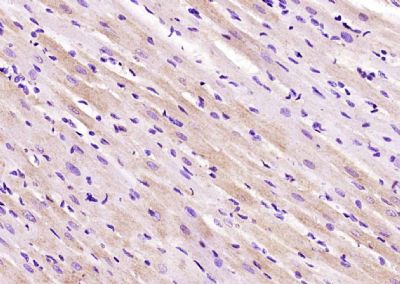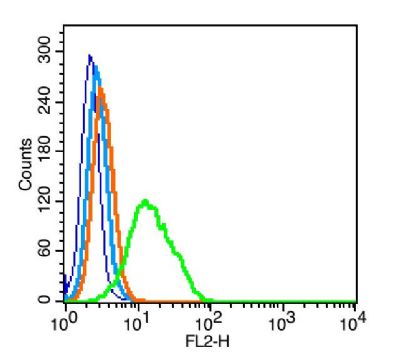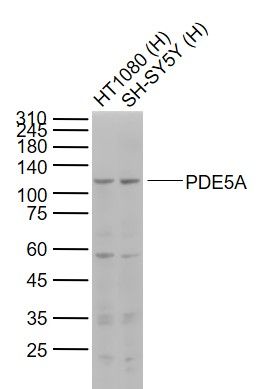PDE5A Polyclonal Antibody
Purified Rabbit Polyclonal Antibody (Pab)
- SPECIFICATION
- CITATIONS
- PROTOCOLS
- BACKGROUND

Application
| WB, IHC-P, IHC-F, IF, E |
|---|---|
| Primary Accession | O76074 |
| Reactivity | Rat, Pig, Dog, Bovine |
| Host | Rabbit |
| Clonality | Polyclonal |
| Calculated MW | 100 KDa |
| Physical State | Liquid |
| Immunogen | KLH conjugated synthetic peptide derived from human PDE5A |
| Epitope Specificity | 101-200/875 |
| Isotype | IgG |
| Purity | affinity purified by Protein A |
| Buffer | 0.01M TBS (pH7.4) with 1% BSA, 0.02% Proclin300 and 50% Glycerol. |
| SIMILARITY | Belongs to the cyclic nucleotide phosphodiesterase family.Contains 2 GAF domains. |
| Post-translational modifications | Phosphorylation is regulated by binding of cGMP to the two allosteric sites (By similarity). Phosphorylation by PRKG1 leads to its activation. |
| Important Note | This product as supplied is intended for research use only, not for use in human, therapeutic or diagnostic applications. |
| Background Descriptions | The cGMP specific phosphodiesterase type 5A (PDE5A) family is comprised of 2 genes (PDE5A and PDE5B) each with multiple splice variants generated by RNA splicing and use of alternate initiation sites. The PDE5 is highly expressed in aorta and lungs, intestine, kidney adrenal gland cerebellum and cerebrum. In cerebellum the PDE5 is highly expressed during neonatal development in Purkinge cells layer. The PDE5 is also abundant in vascular smooth muscle regulating cGMP levels and vascular smooth muscle tonicity. In corpus cavernosum inhibition of PDE5 by sildenafil corrects erectile dysfunctions. The nitric oxide donor sodium notropurside (SNP) stimulate PDE5 activity by cGMP dependent kinase phosphorylation. PDE5A1 has 875 amino acids (99.5 kDa). The amino terminal 142 amino acid of the PDE5 gene showed no sequence homology with other PDEs and also contained serine 92 that is phosphorylated by cGMP kinases. |
| Gene ID | 8654 |
|---|---|
| Other Names | cGMP-specific 3', 5'-cyclic phosphodiesterase, 3.1.4.35, cGMP-binding cGMP-specific phosphodiesterase, CGB-PDE, PDE5A, PDE5 |
| Target/Specificity | Expressed in aortic smooth muscle cells, heart, placenta, skeletal muscle and pancreas and, to a much lesser extent, in brain, liver and lung. |
| Dilution | WB=1:500-2000,IHC-P=1:100-500,IHC-F=1:100-500,IF=1:100-500,Flow-Cyt=0.2 µg/Test,ELISA=1:5000-10000 |
| Format | 0.01M TBS(pH7.4), 0.09% (W/V) sodium azide and 50% Glyce |
| Storage | Store at -20 ℃ for one year. Avoid repeated freeze/thaw cycles. When reconstituted in sterile pH 7.4 0.01M PBS or diluent of antibody the antibody is stable for at least two weeks at 2-4 ℃. |
| Name | PDE5A (HGNC:8784) |
|---|---|
| Synonyms | PDE5 |
| Function | Plays a role in signal transduction by regulating the intracellular concentration of cyclic nucleotides. This phosphodiesterase catalyzes the specific hydrolysis of cGMP to 5'-GMP (PubMed:15489334, PubMed:9714779). Specifically regulates nitric-oxide- generated cGMP (PubMed:15489334). |
| Tissue Location | Expressed in aortic smooth muscle cells, heart, placenta, skeletal muscle and pancreas and, to a much lesser extent, in brain, liver and lung |

Thousands of laboratories across the world have published research that depended on the performance of antibodies from Abcepta to advance their research. Check out links to articles that cite our products in major peer-reviewed journals, organized by research category.
info@abcepta.com, and receive a free "I Love Antibodies" mug.
Provided below are standard protocols that you may find useful for product applications.
If you have used an Abcepta product and would like to share how it has performed, please click on the "Submit Review" button and provide the requested information. Our staff will examine and post your review and contact you if needed.
If you have any additional inquiries please email technical services at tech@abcepta.com.













 Foundational characteristics of cancer include proliferation, angiogenesis, migration, evasion of apoptosis, and cellular immortality. Find key markers for these cellular processes and antibodies to detect them.
Foundational characteristics of cancer include proliferation, angiogenesis, migration, evasion of apoptosis, and cellular immortality. Find key markers for these cellular processes and antibodies to detect them. The SUMOplot™ Analysis Program predicts and scores sumoylation sites in your protein. SUMOylation is a post-translational modification involved in various cellular processes, such as nuclear-cytosolic transport, transcriptional regulation, apoptosis, protein stability, response to stress, and progression through the cell cycle.
The SUMOplot™ Analysis Program predicts and scores sumoylation sites in your protein. SUMOylation is a post-translational modification involved in various cellular processes, such as nuclear-cytosolic transport, transcriptional regulation, apoptosis, protein stability, response to stress, and progression through the cell cycle. The Autophagy Receptor Motif Plotter predicts and scores autophagy receptor binding sites in your protein. Identifying proteins connected to this pathway is critical to understanding the role of autophagy in physiological as well as pathological processes such as development, differentiation, neurodegenerative diseases, stress, infection, and cancer.
The Autophagy Receptor Motif Plotter predicts and scores autophagy receptor binding sites in your protein. Identifying proteins connected to this pathway is critical to understanding the role of autophagy in physiological as well as pathological processes such as development, differentiation, neurodegenerative diseases, stress, infection, and cancer.




